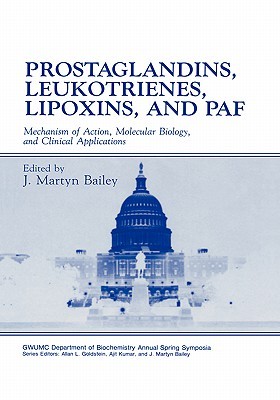
- We will send in 10–14 business days.
- Publisher: Springer
- ISBN-10: 0306440555
- ISBN-13: 9780306440557
- Format: 17.8 x 25.4 x 2.7 cm, hardcover
- Language: English
- SAVE -10% with code: EXTRA
Prostaglandins, Leukotrienes, Lipoxins, and Paf (e-book) (used book) | bookbook.eu
Reviews
Description
The field of eicosanoid metabolism and function continues to grow. Synthesis of the prostaglandins from essential fatty acids was first described by Bergstrom and Sarnuelsson in 1964. The thromboxanes were discovered in 1975, the prostacyclins, by Moncada and Vane, in 1976, and the leukotrienes by Samuelsson in 1979. A new class of biologically active arachidonic acid metabolites named lipoxins was announced by Bengt Samuelsson in May 1984. Since that time major advances have been made in the molecular biology of the eicosanoids including the cloning of prostaglandin synthases and 5, 12, and 15-lipoxygenases from several different species, including man. This volume, Prostaglandins, Leukotrienes, Lipoxins, and P AF: Their Mechanism of Action, Molecular Biology, and Clinical Applications contains most of the papers presented in the plenary sessions of the Xlth International Washington Spring Symposium on Health Sciences. The book is divided into six parts, each covering a different aspect of this rapidly expanding field, and contains a total of 42 chapters by an internationally recognized group of authors in each area. Part I contains 11 chapters and covers the molecular biology and enzymology of prostaglandins and leukotrienes. Chapter 1 by the Editor details new mechanisms for the antiinflammatory glucocorticoids involving translational control of the messenger RNA for prostaglandin synthase. Chapter 2 by Yamamoto describes the molecular evolution of two distinct mammalian 12-lipoxygenases.
EXTRA 10 % discount with code: EXTRA
The promotion ends in 16d.03:23:22
The discount code is valid when purchasing from 10 €. Discounts do not stack.
- Publisher: Springer
- ISBN-10: 0306440555
- ISBN-13: 9780306440557
- Format: 17.8 x 25.4 x 2.7 cm, hardcover
- Language: English English
The field of eicosanoid metabolism and function continues to grow. Synthesis of the prostaglandins from essential fatty acids was first described by Bergstrom and Sarnuelsson in 1964. The thromboxanes were discovered in 1975, the prostacyclins, by Moncada and Vane, in 1976, and the leukotrienes by Samuelsson in 1979. A new class of biologically active arachidonic acid metabolites named lipoxins was announced by Bengt Samuelsson in May 1984. Since that time major advances have been made in the molecular biology of the eicosanoids including the cloning of prostaglandin synthases and 5, 12, and 15-lipoxygenases from several different species, including man. This volume, Prostaglandins, Leukotrienes, Lipoxins, and P AF: Their Mechanism of Action, Molecular Biology, and Clinical Applications contains most of the papers presented in the plenary sessions of the Xlth International Washington Spring Symposium on Health Sciences. The book is divided into six parts, each covering a different aspect of this rapidly expanding field, and contains a total of 42 chapters by an internationally recognized group of authors in each area. Part I contains 11 chapters and covers the molecular biology and enzymology of prostaglandins and leukotrienes. Chapter 1 by the Editor details new mechanisms for the antiinflammatory glucocorticoids involving translational control of the messenger RNA for prostaglandin synthase. Chapter 2 by Yamamoto describes the molecular evolution of two distinct mammalian 12-lipoxygenases.


Reviews